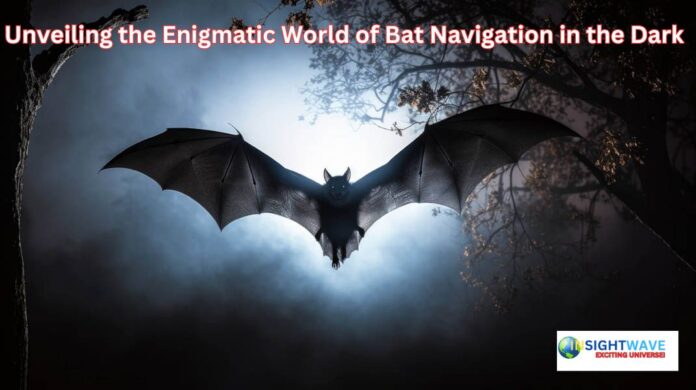Bats, the only mammals capable of sustained flight, have intrigued scientists and nature enthusiasts for centuries. Among the many mysteries surrounding these winged creatures, one of the most fascinating is their ability to navigate in the dark. Bats effortlessly cruise through the night sky, skillfully avoiding obstacles and hunting prey, all while shrouded in darkness. How do they accomplish this extraordinary feat? In this article, we will embark on a journey into the mesmerizing world of bat navigation, exploring the exceptional adaptations and sensory mechanisms that allow these creatures to excel in the absence of light.
Page Contents
The Enigma of Bat Navigation
Bats belong to the order Chiroptera, which comprises over 1,400 species found all around the world, from the dense rainforests to urban cityscapes. What sets these extraordinary mammals apart from other nocturnal creatures is their unique adaptation for navigating through the darkness. Unlike birds that rely heavily on sight, bats have developed an array of sensory mechanisms that allow them to excel in the inky blackness of night.
The primary challenge bats face is that they are primarily active at night or during crepuscular periods when light is limited or absent. They need to find food, avoid predators, and navigate within their environments, all in near total darkness. To overcome these challenges, bats have evolved a range of extraordinary adaptations that enable them to “see” the world around them in their own unique way.
Echolocation: The Key to Bat Navigation
At the heart of a bat’s ability to navigate in the dark is echolocation, a sensory mechanism that allows them to “see” their environment by emitting high-pitched sounds and interpreting the echoes that bounce back. This astonishing skill has become the stuff of legend, inspiring our imaginations and even making appearances in popular culture.
Emitting Ultrasound
Bats emit high-frequency sounds, often beyond the range of human hearing (ultrasound). These sounds can range from clicks and chirps to squeaks, and they are produced by the bat’s vocal cords.
Sound Waves and Echoes
When these ultrasonic waves encounter an object or obstacle in their path, they bounce back as echoes. These echoes contain valuable information about the object’s distance, size, shape, texture, and even its movement.
Advanced Ear Structure
Bats have highly sensitive ears adapted to detect even the faintest echoes. Their ears can move independently to help them pinpoint the source of the sounds and determine the direction and distance of objects in their surroundings.
Processing Information
Bats process the information obtained from echoes almost instantaneously. This processing occurs in the bat’s brain and allows them to create a detailed mental map of their environment, even in complete darkness.
Read Also : The Amazing Camouflage Abilities of Chameleons
Echolocation in Action
Echolocation enables bats to perform incredible feats of navigation and hunting. Let’s explore some of the ways in which bats use this remarkable sensory system:
Hunting
Bats are voracious insectivores, and echolocation is their secret weapon for hunting prey. They emit sonar signals to detect the presence and location of insects in the dark, allowing them to intercept their prey with remarkable accuracy.
Obstacle Avoidance
When flying through dense vegetation or cluttered environments, bats use echolocation to detect and avoid obstacles such as trees, branches, and other flying creatures.
Navigation
Bats can navigate long distances using echolocation. They create a mental map of their territory, identifying landmarks and orienting themselves accurately. This skill is particularly useful for species that migrate or cover large foraging ranges.
Communication
Bats often communicate with each other using echolocation calls. These vocalizations can convey information about their identity, location, and even their emotional state.

Species-Specific Adaptations
Echolocation is a diverse tool, and different bat species have adapted it to their specific needs. Some bats emit sounds that are so loud they can incapacitate or disorient prey. Others have fine-tuned their echolocation to pinpoint tiny insects with incredible precision. Here are a few fascinating examples of species-specific adaptations:
Horseshoe Bats
These bats are known for their distinctive horseshoe-shaped nose leaves, which help focus and direct their echolocation calls. This adaptation enables them to detect prey even in cluttered environments.
Noctule Bats
Noctules are large bats with powerful wings, and they use echolocation to detect flying beetles, moths, and other insects while in flight. Their echolocation calls are often louder and lower in frequency.
Greater Mouse-Eared Bats
These bats have large ears and produce long, continuous echolocation calls, which they use to locate prey on the ground. Their calls can last for several seconds and provide detailed information about the prey’s position and movement.
Myotis Bats
Myotis bats are experts at catching small insects. They emit echolocation calls with rapid, high-pitched pulses, making them ideal for targeting tiny, agile prey.
Nectar-Feeding Bats
Some bat species feed on nectar and fruit. They have adapted their echolocation calls for locating stationary or slow-moving targets, such as flowers and ripe fruit.
Read Also : Ravens and Crows: Feathered Geniuses Among Us
Vision and Other Senses
While echolocation is the primary method of navigation for bats, they also possess other sensory adaptations that complement their ability to “see” in the dark:
Vision
Contrary to popular belief, bats are not blind. Many bat species have functional eyes, and they often rely on vision when ambient light is available. However, their vision isn’t as acute as their echolocation system, which is their primary means of navigating in the dark.
Smell and Taste
Bats have a keen sense of smell and taste, which helps them identify ripe fruit and locate food sources like nectar-producing flowers.
Magnetic Fields
Recent research has suggested that some bats may use the Earth’s magnetic field for navigation, particularly during migration. They have magnetite particles in their brains, which are believed to aid in sensing magnetic fields.
Conclusion
Bats, the only mammals capable of powered flight, have mastered the art of navigation in the dark through the extraordinary power of echolocation. With their ability to emit and interpret high-frequency sound waves, they create a mental map of their environment, allowing them to hunt, avoid obstacles, and communicate with remarkable precision. This skill challenges our perception of intelligence in the animal kingdom and has inspired a deep sense of wonder and admiration.
The more we understand the enigmatic world of bat navigation, the more we appreciate the diversity and complexity of life on our planet. Bats, often misunderstood and even feared, play crucial roles in ecosystems as pollinators and pest controllers. By unraveling the secrets of their remarkable abilities, we gain a deeper appreciation for the intricate web of life in which they are a vital thread.
In a world shrouded in darkness, bats continue to illuminate our understanding of the natural world, reminding us that even in the most challenging environments, life finds remarkable ways to adapt and thrive.


